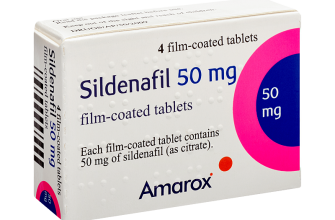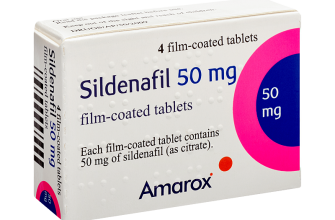Pay attention to the noticeable presence of Viagra ads on television. These commercials aim to inform viewers about the medication while promoting awareness of erectile dysfunction (ED). By directly addressing this health issue, the ads help to destigmatize conversations surrounding men’s health and encourage those experiencing symptoms to seek help.
The visual elements used in these advertisements often highlight relatable scenarios that resonate with a broad audience. Engaging narratives help create a connection, emphasizing the positive impact of the treatment on individuals’ lives and their relationships. This storytelling approach serves not just to market the product, but also to promote a discussion during family gatherings or among friends.
Consider the specific information shared within these ads. They typically include potential side effects, ensuring viewers are well-informed. These disclaimers, spoken rapidly or displayed in fine print, reinforce the importance of consulting with a healthcare professional prior to use. The balanced presentation encourages responsible decision-making while still promoting the product actively.
Overall, Viagra ads exemplify how marketing can contribute to public health dialogues, normalize discussions around men’s sexual health, and inform the audience about available solutions. For many, the visibility of these ads serves as a crucial prompt to take action and address their health concerns.
- Understanding Viagra Ads on TV
- Key Elements of Viagra Advertisements
- Impact on Viewer Behavior
- The Evolution of Viagra Advertising
- Target Audience: Who Sees Viagra Ads?
- The Language of Viagra Commercials
- Regulatory Guidelines for Pharmaceutical Advertising
- The Impact of Viagra Ads on Public Perception
- Shifting Attitudes Towards Sexual Health
- Consumer Behavior and Awareness
- Comparing Viagra Ads: Different Approaches Across Brands
- The Role of Humor and Testimonials in Advertising
- Testimonials as Trust Builders
- Engaging Visuals and Storytelling
- Future Trends in Viagra Advertising on Television
Understanding Viagra Ads on TV
Viagra advertisements on television aim to inform viewers about the medication’s benefits for erectile dysfunction. These ads typically highlight how Viagra can help restore sexual confidence and improve intimate relationships. The messages are designed to resonate with both patients and their partners, creating a connection that encourages conversations about sexual health.
Key Elements of Viagra Advertisements
Viagra ads feature specific components that enhance understanding and appeal:
| Element | Description |
|---|---|
| Informative Content | These ads detail how Viagra works, mentioning increased blood flow to enhance erections. |
| Target Audience | Ads address men aged 40 and older, but also consider their partners, promoting open discussions. |
| Side Effects | Regulatory requirements mandate a clear disclosure of potential side effects, ensuring informed choices. |
| Testimonials | Some ads include testimonials or scenarios showing the positive impacts on relationships post-use. |
Impact on Viewer Behavior
Exposure to these advertisements often leads to greater awareness of erectile dysfunction and encourages individuals to seek medical advice. The combination of straightforward messaging and relatable scenarios helps demystify a sensitive topic. Viewers are more likely to talk to their doctors about symptoms and treatment options after seeing these ads, which can be a significant step toward better health outcomes.
The Evolution of Viagra Advertising
Viagra advertising has transformed significantly since its launch. Initially, marketing focused on medical benefits and clinical efficacy. As acceptance grew, advertisements started to incorporate humor and relatable scenarios.
- Launch Phase (1998): The original ads emphasized Viagra’s role in treating erectile dysfunction (ED), using clinical language and doctor endorsements.
- Awareness Shift (2000s): Ads transitioned to daytime television, showcasing men engaging in everyday activities, portraying ED as a common issue rather than a taboo. This approach aimed to normalize discussions about men’s health.
- Humor and Lifestyle (Mid-2000s): Campaigns included light-hearted depictions, often featuring couples enjoying romantic moments. This created a more intimate connection with viewers and removed some stigma.
- Inclusivity and Diversity (2010s): Advertisements began to reflect various demographics, showcasing a broader spectrum of relationships and lifestyles. This change allowed the brand to reach a wider audience.
- Digital Shift (2020s): With an increase in online viewing, Viagra ads adapted to social media platforms. Shorter, impactful videos addressed younger audiences, focusing on overall wellness rather than just ED.
Future strategies may involve deeper engagement through online communities, addressing men’s health comprehensively while continuing to humanize the conversation around ED.
Target Audience: Who Sees Viagra Ads?
Viagra ads primarily target men aged 40 and older who experience erectile dysfunction. This demographic is often facing health issues related to aging, such as cardiovascular problems or diabetes, which can impact sexual performance. Advertisers focus on providing a solution to restore confidence and intimacy.
Additionally, partners of these men also become an audience. Ads often highlight the importance of communication in relationships, encouraging women to support their partners in seeking help. Creative messaging aims to create a sense of shared experience and understanding.
Another segment includes healthcare providers, who may influence patients’ choices regarding treatment options. Educating doctors about the benefits and use of Viagra through advertising encourages them to recommend it to suitable patients.
Media strategies target a variety of platforms, including cable television and online streaming services, where men in this age group are likely to engage. Programs catering to lifestyle, health, and reunions often serve as prime slots for airing these commercials.
In summary, targeting both men and their partners, along with healthcare providers, creates a multi-faceted approach to Viagra advertising, addressing the emotional and physical aspects of erectile dysfunction.
The Language of Viagra Commercials
Viagra commercials utilize straightforward and relatable language that resonates with their target audience. The messaging focuses on empowerment, highlighting the ability to regain confidence in intimate relationships. Phrases like “Don’t let erectile dysfunction hold you back” convey a sense of liberation and encourage viewers to take action.
Visual elements complement the language effectively. The imagery in these ads often features happy couples engaging in everyday activities, reinforcing the idea of renewed intimacy and connection. The tone remains positive and reassuring, promoting a sense of hope and possibility through the product.
Clear calls-to-action are integral to the messaging. Viewers are prompted to consult a healthcare provider or visit the website for more information, creating a direct link between the ad and potential next steps. This approach demystifies the subject, making it easier for men to seek help without stigma.
Health disclaimers are present but presented in a concise manner. The medical information is typically delivered at a measured pace, ensuring that key facts are absorbed without overwhelming the viewer. This balance maintains trust while addressing safety concerns surrounding the medication.
Finally, the repetition of key phrases, like “ask your doctor,” reinforces the importance of medical guidance. By repeating these terms, commercials build familiarity and urgency, prompting viewers to prioritize their health and well-being. This language creates an inviting atmosphere where taking charge of one’s health feels approachable and achievable.
Regulatory Guidelines for Pharmaceutical Advertising
Pharmaceutical companies must ensure their advertising complies with regulatory standards set by agencies like the Food and Drug Administration (FDA) in the United States. Advertisements must present balanced information, including both benefits and risks associated with the drug. This means that any advertising for Viagra or similar medications must include clear disclaimers regarding possible side effects.
Direct-to-consumer advertisements must avoid misleading claims and should provide adequate information that supports the claims made about the product. The language used must be straightforward and understandable to a general audience, avoiding overly technical jargon. The FDA requires that any promotional materials clarify who the product is intended for and under what conditions it should be used.
Timing and frequency of ads are also monitored. Advertisements cannot overwhelm viewers or run excessively. Companies should monitor the reception of their ads and adjust campaigns based on feedback to maintain compliance and positive public perception.
To maintain transparency, it is advisable to include information on how to contact healthcare providers for more details. Shifting focus to responsible marketing practices enhances trust and engages consumers in informed decision-making about their health options.
The Impact of Viagra Ads on Public Perception
Viagra advertisements significantly influence how society views erectile dysfunction and related treatments. These ads promote open conversations about intimacy and health, challenging longstanding stigmas associated with sexual dysfunction. More individuals start to seek help when they see prominent messaging that normalizes the issue. This awareness leads to increased consultations with healthcare providers, breaking down barriers to treatment.
Shifting Attitudes Towards Sexual Health
The portrayal of Viagra in commercials contributes to a more positive attitude toward sexual health. Many people now recognize erectile dysfunction as a common condition that can be effectively managed. By moving discussions from the shadows into mainstream media, these ads encourage a normalization of seeking solutions. As a result, individuals feel less shame and more empowerment to address their needs.
Consumer Behavior and Awareness
The accessibility of Viagra advertisements boosts consumer knowledge about available options. Potential customers become more informed about symptoms and treatment methods. Such awareness fosters proactive behavior in addressing sexual health concerns rather than waiting until issues become severe. Consequently, this leads to a healthier population, more informed about their well-being and choices.
Comparing Viagra Ads: Different Approaches Across Brands
Viagra ads vary significantly in their messaging and presentation strategies. Each brand aims to connect with its target audience in a unique way. Here are some standout approaches:
- Humor and Lightheartedness: Some brands opt for a humorous take, using comedic scenarios to create relatability. This approach makes the topic more approachable, breaking down stigma and inviting open conversations.
- Romantic and Emotional Appeal: Other advertisements emphasize intimacy and emotional connection. By showcasing romantic moments, they highlight the positive impact of Viagra on relationships, appealing to feelings of love and connection.
- Direct and Informative: Certain ads focus on providing clear, straightforward information about the product. This method targets consumers seeking facts, outlining benefits and usage without sugarcoating the message.
- Testimonial-Based Stories: Some brands feature real-life testimonials from users. These narratives create trust and authenticity, demonstrating personal experiences and the product’s effectiveness.
- Visual Storytelling: Engaging visuals play a key role in many ads. Through captivating imagery, brands illustrate the freedom and confidence Viagra can bring, making a compelling case for its use.
Each strategy has its strengths, resonating with different demographic groups. Brands that master the balance of creativity and clarity often stand out, ensuring their message reaches the intended audience effectively.
The Role of Humor and Testimonials in Advertising
Incorporating humor into Viagra ads creates a memorable experience, making the product approachable. Jokes that resonate with everyday situations help break the ice regarding sensitive topics like erectile dysfunction. Studies show humor increases viewer recall, resulting in higher brand recognition. Advertisers often use light-hearted scenarios to disarm potential users, fostering a sense of comfort.
Testimonials as Trust Builders
Testimonials serve as powerful endorsements. Real users sharing their success stories enhance credibility and create emotional connections. Prospective customers often relate to these experiences, finding reassurance in the effectiveness of the product. Including diverse testimonials ensures a broader audience feels represented, further boosting trust. Integrating these authentic voices alongside humor strikes a balance that resonates well with viewers.
Engaging Visuals and Storytelling
Combining humor and testimonials within engaging visual narratives strengthens the ad’s impact. Clever sketches or relatable animations paired with genuine testimonials provide an entertaining yet informative message. This storytelling approach keeps viewers engaged while conveying essential information about the product’s benefits, ultimately driving home the value of using Viagra.
Future Trends in Viagra Advertising on Television
Advertisers will increasingly personalize Viagra commercials, tailoring content based on viewer demographics and preferences. Utilizing advanced data analytics, brands can serve targeted advertisements that resonate more effectively with specific audiences, enhancing engagement rates.
Product narratives will shift toward inclusive messaging, portraying a broader spectrum of relationships and experiences. This approach will reflect changing social norms and encourage open discussions about sexual health, making the ads relatable to diverse viewers.
Another trend will be the integration of health-conscious themes into Viagra advertisements. Highlighting overall well-being and the importance of communication in relationships will create a more holistic narrative, reducing stigma attached to the product.
Innovations in augmented reality (AR) and virtual reality (VR) can transform advertisement experiences. Brands may use these technologies to create immersive engagement, allowing viewers to explore benefits in a compelling format that captures attention.
Collaborations with health professionals for informative segments will likely increase. These partnerships can clarify the medical benefits and safety of Viagra, encouraging consumers to view the product as part of a broader health conversation.
Incorporating user-generated content could also gain traction. Sharing authentic testimonials fosters trust and aligns the brand with real experiences, breaking through the traditional advertising barrier and enabling viewers to connect on a personal level.
As public awareness of mental health grows, Viagra advertisements may address the psychological aspects of sexual performance. Strategically blending medical and emotional narratives will resonate with viewers, positioning the brand as supportive and understanding of couples’ challenges.
Finally, sustainability will play a role in advertising strategies. Highlighting eco-friendly practices in production and packaging can appeal to environmentally conscious consumers, aligning the brand with contemporary values and enhancing its overall image.







